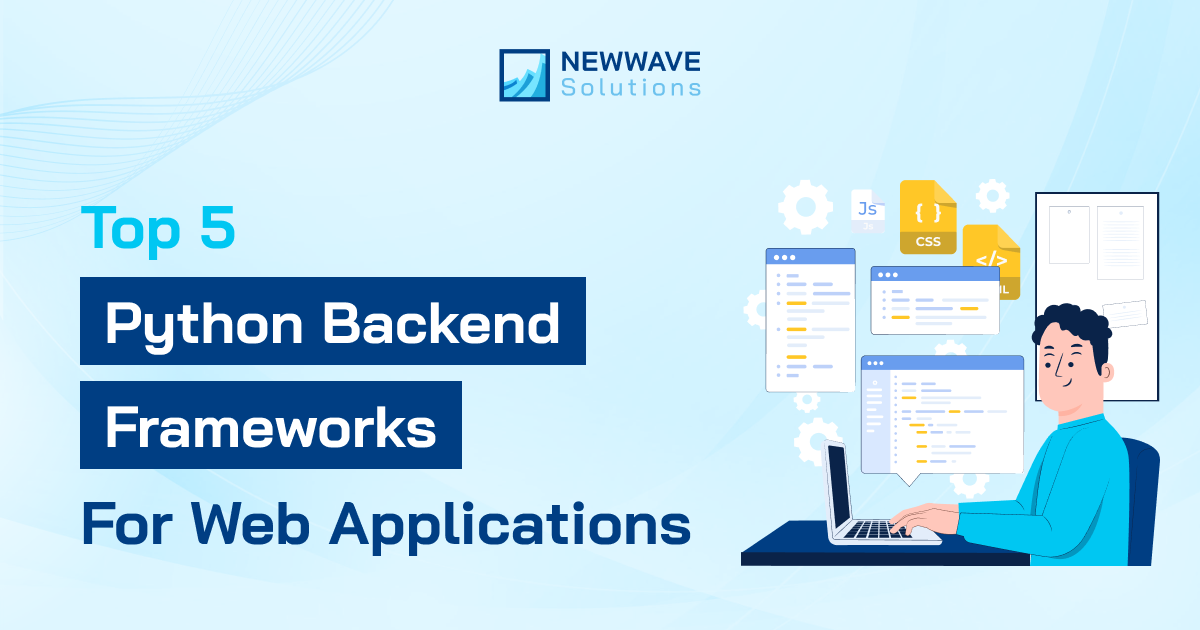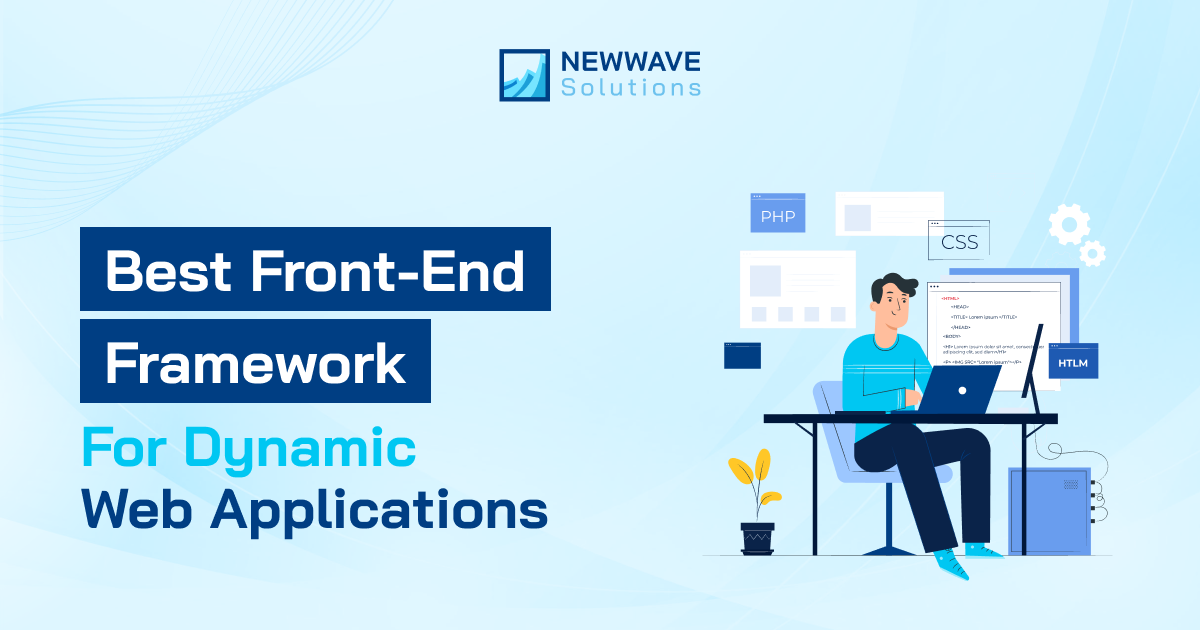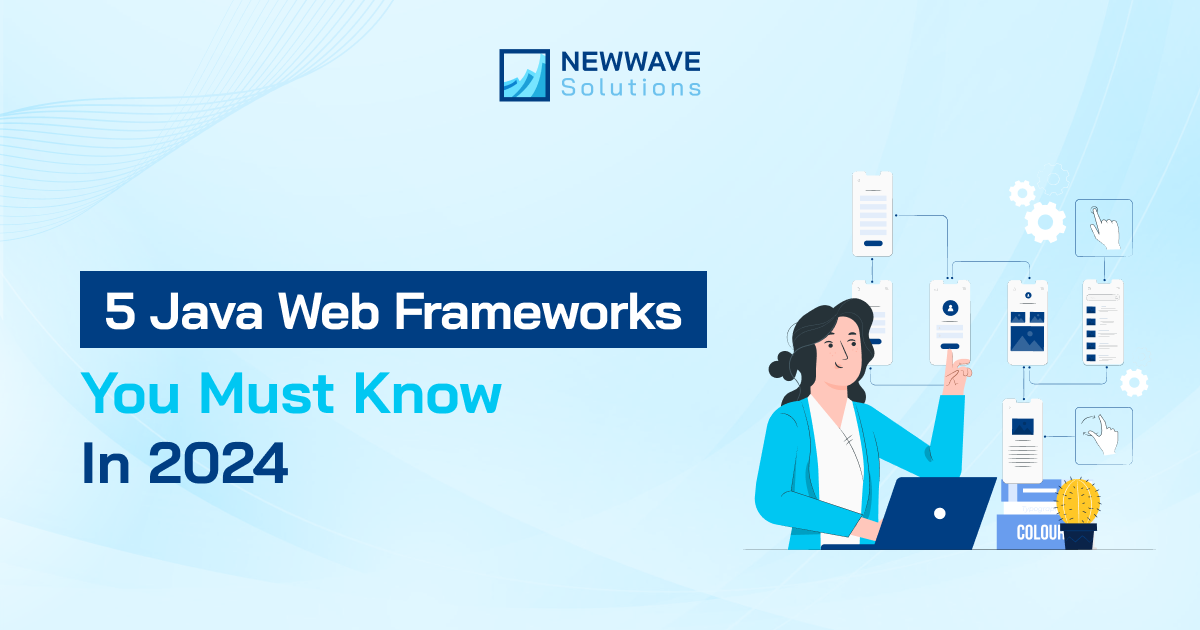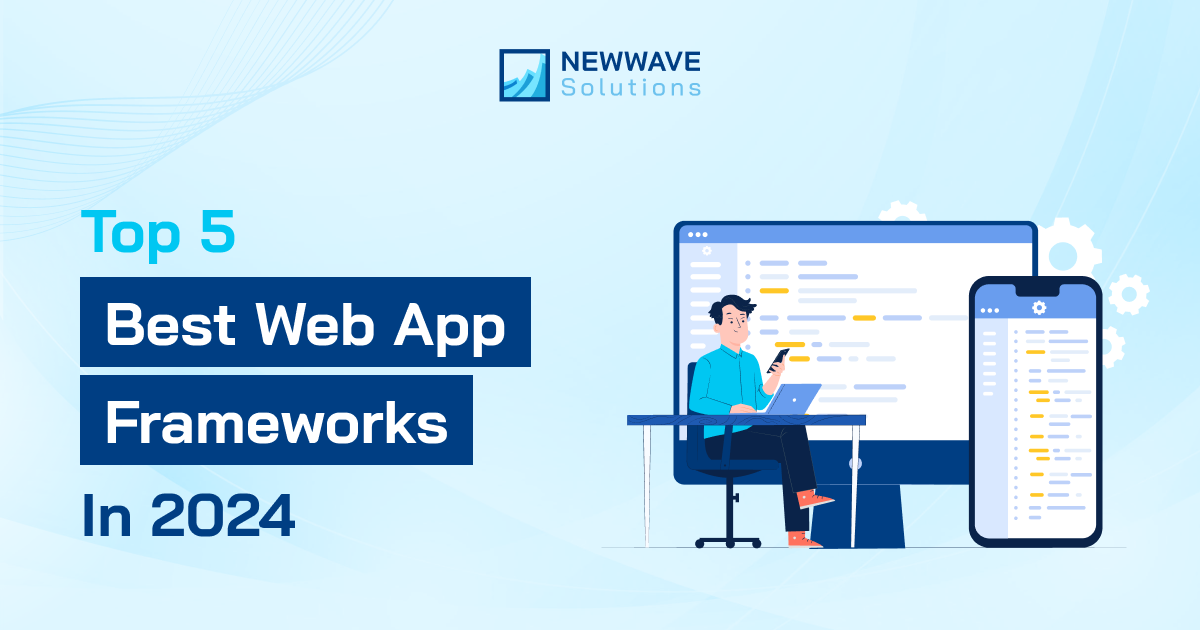

Top 5 High-Performance Python Backend Frameworks for Web Applications

As the demand for dynamic and scalable web applications continues to soar, Python has emerged as a frontrunner among programming languages for backend development. Its user-friendly syntax, vast library support, and cross-platform compatibility make it an ideal choice for crafting robust web solutions.
In this comprehensive guide, we’ll embark on a journey through the realm of Python backend frameworks. Whether you’re a seasoned developer or just starting, this guide will equip you with the knowledge and insights to select the perfect Python backend framework for your next project.
Table Of Contents
Toggle1. What is a Python Backend Framework?

In the realm of web development, the backend is responsible for the server-side logic and functionality that powers a website or application. It handles tasks like data processing, database interactions, and user authentication, ensuring a seamless and secure user experience.
Python backend frameworks are powerful tools that provide a structured and organized approach to building robust and scalable backend applications using the versatile Python programming language. These frameworks offer a collection of pre-built components, libraries, and functionalities that streamline development processes, saving time and effort for developers.
2. Is Python Useful for the Backend?
Python’s popularity extends beyond general-purpose programming and shines brightly in the realm of backend development. Leveraging a Python backend framework, like the widely-used Django Python framework or the versatile Python web framework Flask, empowers developers to construct robust and secure web applications efficiently.

Here’s how Python backend frameworks empower developers:
- Rapid Development: Python backend frameworks provide pre-built components and functionalities, accelerating development compared to building everything from scratch. This translates to faster time-to-market for your web application.
- Security: Peace of mind comes standard with Python backend frameworks as they often incorporate industry best practices and security measures. This inherent focus on security helps safeguard web applications from potential threats and vulnerabilities.
- Scalability: As your business flourishes, so too will your web application’s traffic and data demands. Python backend frameworks are built with scalability in mind, ensuring your application can seamlessly adapt and grow alongside your needs.
- Maintainability: Python backend frameworks promote well-organized and reusable code. This structured approach simplifies maintenance and future updates for your web application, keeping it running smoothly.
- Community Support: The widespread adoption of prominent Python backend frameworks fosters large and active developer communities. These communities offer invaluable resources, documentation, and ongoing support, making the development journey a breeze.
Choosing the best backend framework Python offers can depend on your project’s specific requirements. Explore the various options available, like Django and Flask, to find the perfect fit for your needs.
See more: Top Ten Backend Frameworks For Modern Web Development
3. Different Types of Python Backend Web Framework

Choosing the right Python backend framework can significantly impact your web development project. Python offers a variety of frameworks, each with its strengths and use cases. Let’s explore some popular options to guide you in selecting the best Python backend framework for your needs.
3.1. Full Stack Framework
For projects requiring a comprehensive solution, consider full-stack frameworks like Django. These frameworks act as a one-stop shop, providing built-in features for:
- Frontend development: Django python framework handles the user interface (UI) aspects of your application.
- Backend logic: The framework takes care of the server-side operations that power your application’s functionality.
- Database management: Django python framework simplifies database interactions, allowing you to store and retrieve data efficiently.
- Additional features: Many full-stack frameworks offer functionalities like security measures, user authentication, and administrative tools.
This Django Python framework is ideal for large-scale applications where a Python backend web framework is needed alongside the frontend development aspects. If you’re looking for a Python backend framework list to kickstart development, Django is an excellent starting point.
3.2. Micro-framework
For smaller projects or situations where you value customization over built-in features, consider micro-frameworks like Python web framework Flask. These lightweight frameworks provide the core components for web development, allowing you to tailor the application to your exact needs.
Here’s what makes micro-frameworks like Flask stand out:
- Minimalistic and lightweight: They are ideal for projects where a simple and efficient backend is essential.
- Flexibility: Micro-frameworks allow you to choose the specific libraries and tools that best suit your project requirements. This level of control is particularly attractive to developers who prefer a hands-on approach.
- Focus on essentials: Micro-frameworks prioritize core web development functionalities, making them a great choice for building APIs (Application Programming Interfaces) or smaller web applications.
3.3. Asynchronous Framework
As the complexity of web applications grows, handling multiple requests simultaneously becomes critical. This is where asynchronous frameworks like Hug come into play. These frameworks are built for performance optimization by utilizing asynchronous programming techniques.
Here’s how asynchronous frameworks excel:
- Concurrency: They efficiently handle multiple tasks at once, ensuring your application remains responsive even under heavy load. This is particularly beneficial for applications that deal with real-time data or require high user interaction.
- Non-blocking execution: Asynchronous frameworks prevent a single request from blocking the processing of others. This translates to a smoother user experience and improved overall application performance.
While asynchronous frameworks offer significant performance advantages, they might have a steeper learning curve compared to full-stack or micro-frameworks. Consider your project’s specific needs and your development team’s experience when evaluating asynchronous frameworks like Hug.
Choosing the right Python backend framework empowers you to build robust and scalable web applications. By understanding the strengths and use cases of full-stack frameworks, micro-frameworks, and asynchronous frameworks, you can make an informed decision that aligns perfectly with your project’s requirements.
4. Top 5 Python Backend Frameworks You Should Consider

The choice of a Python backend framework depends on the specific requirements and preferences of a project. Factors to consider include project size, complexity, performance needs, developer expertise, and community support.
Popular Python backend frameworks include Django, Flask, Pyramid, Bottle, and CherryPy, each with its strengths and characteristics. Let’s find out the Python backend framework list below:
4.1. Django: The All-Rounder
Django is a powerful and versatile Python backend framework that shines for a wide range of projects. It’s a full-stack framework, meaning it offers everything you need to build a web application, from routing and templating to user authentication. This makes it a popular choice for developers seeking a comprehensive solution.

Open-source and free-to-use, Django stands out among Python backend frameworks. It’s a full-stack framework in maintenance mode (meaning it receives critical bug fixes), but also offers an asyncio library for asynchronous programming. Unlike some frameworks that rely on individual libraries for functionality, Django boasts a variety of built-in features right out of the box.
Built on the ‘Don’t Repeat Yourself (DRY)’ and ‘Explicit over Implicit’ principles, Django promotes clean and efficient code. This Python backend web framework utilizes an Object Relational Mapper (ORM) to seamlessly map objects to database tables. This allows your code to work with various databases and template engines, simplifying database migrations.
Speaking of databases, Django offers support for popular options like MySQL, SQLite, PostgreSQL, and Oracle. This Python MVC framework doesn’t stop there; it can extend its reach to other databases and templating systems through third-party adapters, and drivers, and even integrate with content management systems.
Django’s robust features make it a strong contender compared to other Python backend frameworks. Localization support, user authentication, sessions, cookies, web server integration, and exceptional web browser compatibility are just some of the reasons developers favor it.

Pros of Django:
- A mature and stable framework with a large and active community
- “Batteries-included” approach – no need for extra libraries for common tasks
- Beginner-friendly with a clear learning curve
- Highly scalable, capable of handling high-traffic websites
Cons of Django:
- May be overkill for very simple projects
- Complex projects might have a steeper learning curve
Exceptional Features of Django:
- Versatile and user-friendly Object Relational Mapper (ORM)
- URL routing and templating system
- Automatic migration capabilities
- Built-in admin panel generation
- Security features like XSS and CSRF prevention
- Support for geographical data and spatial queries with GeoDjango
- Extensive collection of ready-to-use libraries
Overall, Django is a top contender among Python backend frameworks. Its versatility makes it ideal for developing complex modern web applications. Whether you’re a seasoned developer or just starting with Python backend web frameworks, Django is worth considering.
See more: Top 5 Top-Rated Best Web App Frameworks in 2024
4.2. Flask: The Microframework
This lightweight Python framework excels at building small to medium web apps. Unlike comprehensive frameworks, Flask focuses on core backend functionalities, offering flexibility and customization. Developers can integrate specific libraries for tasks like authentication or utilize Object-Relational Mappers (ORMs) like SQLAlchemy for database interaction.
The flask’s simplicity keeps it beginner-friendly. While lacking some built-in features compared to Django, Flask’s modular design and lightweight nature empower developers to craft tailor-made applications. Its features like routing, templating, and unit testing support ensure code quality and a smooth development workflow.

Pros:
- Lightweight and easy to use
- Highly flexible and customizable
- Great for building small to medium-sized web applications
Cons:
- Not a full-stack framework, so you will need to install additional libraries for some tasks
- Can be more difficult to learn for beginners
Flask Framework offers the following features:
|
Core Functionalities |
Advanced Features |
| Routing |
Error logging and ticketing |
| Templating language (Jinja2) |
Role-based access control |
| Session management |
Pluggable model |
| Complete unit testing support |
First-class REST support and coordination |
| Inbuilt development web server |
Blueprint support |
| WSGI compliant with HTTP request handling |
Pluggable ORM and secure cookies |
| Static file uploads and serving |
Flexible web application sections |
| Built-in fast debugger |
While Flask offers numerous advantages, it’s important to consider potential drawbacks. Because it’s not a full-stack framework, you might need to install additional libraries for some functionalities that might be readily available in other frameworks. This can also add to the initial learning curve for beginners compared to a more comprehensive framework.
Overall, Flask is a powerful and versatile Python backend framework. Whether you’re a seasoned developer seeking a customizable solution or exploring backend development with Python, Flask offers a compelling option for your next web application project.
4.3. Pyramid: The Flexible Framework
Python backend frameworks, like Pyramid, act as the foundation for developing web applications. They streamline the development process by providing pre-built functionalities for common tasks like database interaction, URL routing, and templating. This empowers developers to focus on core application logic, accelerating development time.
Pyramid, a powerful WSGI-based Python web framework, caters to developers seeking flexibility and customization. Its modular design allows you to build applications tailored to your specific needs, unlike some more opinionated frameworks. While its popularity might not match Django or Flask, Pyramid boasts a supportive community and offers excellent documentation, making it a worthy contender in the best Python backend framework list.

Here’s a breakdown of Pyramid’s key strengths:
- Unmatched Flexibility: Pyramid excels in offering a highly customizable development experience. Unlike frameworks with a rigid structure, Pyramid empowers you to design your application architecture freely.
- WSGI Compatibility: Built upon the WSGI protocol, Pyramid seamlessly integrates with various web servers, offering deployment versatility. This makes it a strong choice for projects requiring adaptability.
- Complex Application Champion: Pyramid shines when it comes to building intricate web applications. Its modular design empowers you to meticulously craft applications that cater to demanding functionalities.
While Pyramid boasts these advantages, it’s essential to consider its potential drawbacks:
- Community Sparsity: Compared to Django and Flask, Pyramid’s community might be smaller. This could translate to fewer readily available resources and solutions online.
- Learning Curve Consideration: The increased flexibility of Pyramid can also come with a steeper learning curve for beginners. Developers familiar with more structured frameworks might require additional time to grasp Pyramid’s nuances.
In conclusion, Pyramid is a compelling Python backend framework for developers seeking maximum control and customization in their web applications. Its strengths in flexibility, WSGI compatibility, and complex application development make it a valuable asset in the right hands. If you’re looking for a framework that empowers you to craft unique web experiences, Pyramid is worth exploring.
4.4. Bottle: The Minimalist Framework
The Bottle framework stands out as a popular Python backend framework within the web development community. It allows you to create various web applications using Python with a focus on simplicity and ease of use.
Unlike many other Python backend frameworks, Bottle boasts a minimalist design. It relies solely on the Python standard library, keeping its dependencies minimal. This translates to a single file containing the entire framework, further enhancing its lightweight nature. Additionally, Bottle is distributed as a source file module.
This Python web framework offers built-in features like a template engine, exception handling, and various functions. These functionalities can be directly utilized by your Python code, eliminating the need for frequent import statements.

One of the key strengths of Bottle lies in its ability to empower developers to work “closer to the hardware.” This makes it ideal for programmers seeking a flexible and lightweight solution for building basic web applications and websites. Bottle integrates seamlessly with third-party HTTP/WSGI servers, providing further flexibility to developers.
Another advantage of Bottle is its small footprint. This makes it a breeze to embed within larger applications without introducing burdensome system-wide requirements.
Choosing the best Python backend framework depends on your project’s specific needs. Bottle shines for those seeking a clean, simple, and fast framework to develop small business applications.
Pros of Bottle:
- Extremely lightweight and beginner-friendly
- Well-suited for building simple web applications
Cons of Bottle:
- Lacks the extensive feature set of some other frameworks
- Might pose a steeper learning curve for absolute beginners
Key Features of Bottle:
- Built-in template engine with good performance
- Compatible with popular templating engines like Jinja2, Mako, and Cheetah
- Built-in HTTP development server for streamlined development workflows
- Support for dynamic URL generation for a more elegant API design
- Plugin support for various databases, making data integration a breeze
- Seamless handling of file uploads, headers, cookies, and sessions
Bottle provides a valuable option for developers seeking a lightweight and user-friendly Python backend framework. Its simplicity, speed, and ease of use make it ideal for building basic web applications and integrating web functionality into larger projects. Consider Bottle if you prioritize a streamlined development experience and a fast, efficient backend for your web application.
4.5. CherryPy: The Object-Oriented Framework
Similar to Django, CherryPy is an object-oriented framework based on the WSGI protocol. This makes it a great choice for developers seeking a powerful and adaptable Python backend framework that’s also beginner-friendly.
CherryPy stands out for its ease of use and flexibility. It offers built-in HTTP/1.1 compliant WSGI multi-threaded web servers, allowing for rapid web application development. Developers can leverage their preferred coding styles to build applications and establish database connections within the framework. Additionally, CherryPy’s multi-threaded web server ensures smooth application viewing.
A significant advantage of CherryPy is its cross-platform compatibility. You can run applications on any Python-supported operating system, including Windows, Mac, Linux, or Unix. This makes it a versatile choice for diverse development environments.

CherryPy excels at enabling developers to quickly develop applications with minimal code. It offers features like controller modules and a setup framework, simplifying data access, file uploads, templating engines, and session management. Notably, it provides built-in support for documentation tasks like coverage, testing, and profiling, enhancing project maintainability.
One of CherryPy’s core strengths lies in its ability to run multiple HTTP web servers concurrently. This feature makes it ideal for situations requiring high performance and scalability.
Here’s a quick recap of CherryPy’s key benefits:
- Powerful and Flexible: Ideal for complex projects requiring versatility.
- Easy to Learn and Use: Beginner-friendly with a smooth learning curve.
- WSGI Compliant: Integrates seamlessly with various web servers.
- Cross-Platform Compatibility: Runs on Windows, Mac, Linux, and Unix.
- Fast Development: Enables rapid application development with minimal code.
- Multiple HTTP Server Support: Handles high-performance requirements.
Feature Checklist For CherryPy Framework:
- HTTP/1.1-compliant WSGI thread-pooled web server
- Multiple HTTP Server Support
- Powerful installation and configuration system
- Flexible plugin system
- Minimalism concepts
- Faster development time
- Android Compliant
While CherryPy boasts numerous advantages, it’s important to consider potential drawbacks. It may not have the same level of widespread recognition as Django or Flask. Additionally, some advanced tasks might have a steeper learning curve compared to other frameworks.
Overall, CherryPy presents itself as a valuable option for developers seeking a user-friendly and adaptable Python backend framework. Its focus on rapid development, cross-platform compatibility, and multiple HTTP server support make it a strong contender for various web application projects. Remember, the “best” framework depends on your project’s specific needs and your development preferences. Consider exploring different options like Django and Flask to make an informed decision.
See more: 5 Java Web Frameworks You Must Know in 2024
5. Conclusion
Python boasts a vast collection of Python backend frameworks, empowering developers to tackle diverse project requirements with ease. These frameworks, ranging from comprehensive full-stack frameworks like Django to minimalist micro-frameworks like Flask, each offer unique strengths and functionalities.
Selecting the ideal Python backend framework hinges on several key considerations: the project’s complexity, required scalability, performance benchmarks, and the development team’s expertise in various frameworks. A thorough understanding of each framework’s core features and capabilities equips developers to make an informed decision and select the best backend framework suited perfectly for their specific web development projects.
Connect to Newwave Solutions to explore how our team of Python web development experts can assist you in selecting and implementing the ideal Python backend framework to propel your project toward success.
Contact Information:
- Head Office (Hanoi): 1F, 4F, 10F, Mitec Building, Duong Dinh Nghe Street, Yen Hoa Ward, Cau Giay District, Hanoi City, Vietnam
- Branch Office (Tokyo): 1chōme118 Yushima, Bunkyo City, Tokyo 1130034, Japan
- Hotline: +84 985310203
- Website: https://newwavesolution.com
- Email: [email protected]
Tags
To Quang Duy is the CEO of Newwave Solutions, a leading Vietnamese software company. He is recognized as a standout technology consultant. Connect with him on LinkedIn and Twitter.













